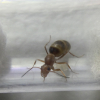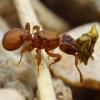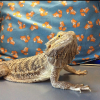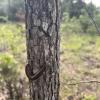- Formiculture.com
- Forums
- Gallery
- Members
- Member Map
- Chat
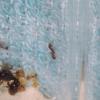
Pheidole? LI, NY.
Started By
LIExotics
, Jul 18 2022 10:21 AM
28 replies to this topic
#1
 Offline
-
Posted July 18 2022 - 10:21 AM
Offline
-
Posted July 18 2022 - 10:21 AM
Hey everyone. So I caught these queens about 3 months ago, and I thought they were Monomorium queens. But, today I noticed a few workers hatched out over the last week (last time I checked on them) and they are very light brown in color, which I couldn't find any Monomorium species that have these light brown, almost yellow, transparent workers. I've included some pics but they are not the best quality, but, they were the best pictures I could get with the camera on my phone. Hopefully the pics are enough to get an ID. The queens are been 4 and 5mm. And the workers are between 1.5 and 2mm.
Here are the pics: https://imgur.com/gallery/Fu7JQpp
Thanks in advance everyone.
Here are the pics: https://imgur.com/gallery/Fu7JQpp
Thanks in advance everyone.
#2
 Offline
-
Posted July 18 2022 - 10:23 AM
Offline
-
Posted July 18 2022 - 10:23 AM
You're sure those were caught in NY? This looks like Pheidole navigans, an exotic species that's introduced to much of the southern US; but definitely not as far north as Long Island.
- OiledOlives and FloridaAnts like this
#3
 Offline
-
Posted July 18 2022 - 11:19 AM
Offline
-
Posted July 18 2022 - 11:19 AM
Those definitely look like some species of Pheidole. Could be navigans, like Cheeto said.
- ColAnt735 and FloridaAnts like this
"Float like a butterfly sting like a bee, his eyes can't hit what the eyes can't see."
- Muhammad Ali
Check out my shop and parasitic Lasius journal! Discord user is bmb1bee if you'd like to chat.
Also check out my YouTube channel: @bmb1bee
#4
 Offline
-
Posted July 18 2022 - 11:22 AM
Offline
-
Posted July 18 2022 - 11:22 AM
Uh oh!
"The ants are a people not strong, yet they prepare their meat in the summer." Prov. 30:25
Keep ordinary ants in extraordinary ways.
Keep ordinary ants in extraordinary ways.
#5
 Offline
-
Posted July 18 2022 - 11:25 AM
Offline
-
Posted July 18 2022 - 11:25 AM
Did you go on a trip out of state, find some and bring then back? To me that's the most logical reason
- Jonathan5608 likes this
#6
 Offline
-
Posted July 18 2022 - 12:20 PM
Offline
-
Posted July 18 2022 - 12:20 PM
I read in an article some species of a pheidole in NY had super majors, but apparently they could never find the colony again. New species? Kind of interesting…
#7
 Offline
-
Posted July 18 2022 - 12:49 PM
Offline
-
Posted July 18 2022 - 12:49 PM
Pheidole davisi? If it's one of the native species.
#8
 Offline
-
Posted July 18 2022 - 12:50 PM
Offline
-
Posted July 18 2022 - 12:50 PM
Definitely P. navigans.
Hi there! I went on a 6 month or so hiatus, in part due, and in part cause of the death of my colonies.
However, I went back to the Sierras, and restarted my collection, which is now as follows:
Aphaenogaster uinta, Camponotus vicinus, Camponotus modoc, Formica cf. aserva, Formica cf. micropthalma, Formica cf. manni, Formica subpolita, Formica cf. subaenescens, Lasius americanus, Manica invidia, Pogonomyrmex salinus, Pogonomyrmex sp. 1, Solenopsis validiuscula, & Solenopsis sp. 3 (new Sierra variant).
#9
 Offline
-
Posted July 18 2022 - 6:26 PM
Offline
-
Posted July 18 2022 - 6:26 PM
Definitely P. navigans.
Now should he report it or something by sending a dead worker in?
#10
 Offline
-
Posted July 18 2022 - 6:55 PM
Offline
-
Posted July 18 2022 - 6:55 PM
I found these at Belmont lake state park in Babylon New York. And I agree with everyone here. It shouldn't be in NY. I found 3 species that were identical to this. But 2 of them don't even live in the United States, and the other lives in Florida to Louisiana. If this is indeed a species that doesn't live in NY at all, then let me know who to send some to to alert the proper people that we have a species here that shouldn't be here. But mind you, these ants are all over the place at this park, as well as 2 other parks I search for ants at. I always thought they were "little black ants" Monomorium minimum. It's very interesting to find out that these are actually a species that shouldn't be here.
#11
 Offline
-
Posted July 18 2022 - 6:58 PM
Offline
-
Posted July 18 2022 - 6:58 PM
Did you go on a trip out of state, find some and bring then back? To me that's the most logical reason
No. These are caught right here on long Island at a state park. I've got 12 parks/forest areas I search for ants here on long Island. And I always thought these were monomorium minimum. I caught 7 of these queens about 3 months ago. I've got 3 in one tube and 4 in another. I had no idea these were pheidole. Now I'm really curious why they are here.
#12
 Offline
-
Posted July 18 2022 - 7:29 PM
Offline
-
Posted July 18 2022 - 7:29 PM
Definitely P. navigans.
I agree
I keep: C. modoc, C. sansabeanus ![]() , C. maritimus, Formica argentea, M. mexicanus
, C. maritimus, Formica argentea, M. mexicanus ![]() , Odontomachus brunneus
, Odontomachus brunneus ![]() , Pogonomyrmex californicus, Pogonomyrmex rugosus,
, Pogonomyrmex californicus, Pogonomyrmex rugosus,
#13
 Offline
-
Posted July 18 2022 - 7:49 PM
Offline
-
Posted July 18 2022 - 7:49 PM
Did you go on a trip out of state, find some and bring then back? To me that's the most logical reason
No. These are caught right here on long Island at a state park. I've got 12 parks/forest areas I search for ants here on long Island. And I always thought these were monomorium minimum. I caught 7 of these queens about 3 months ago. I've got 3 in one tube and 4 in another. I had no idea these were pheidole. Now I'm really curious why they are here.
They hitched a ride in a houseplant or something maybe…
#14
 Offline
-
Posted July 19 2022 - 9:31 AM
Offline
-
Posted July 19 2022 - 9:31 AM
Not good news, but can they survive the winters there?
"The ants are a people not strong, yet they prepare their meat in the summer." Prov. 30:25
Keep ordinary ants in extraordinary ways.
Keep ordinary ants in extraordinary ways.
#15
 Offline
-
Posted July 19 2022 - 9:37 AM
Offline
-
Posted July 19 2022 - 9:37 AM
It gets pretty cold. Usually below 20-30.
Edited by Jonathan5608, July 19 2022 - 9:38 AM.
#16
 Offline
-
Posted July 19 2022 - 1:02 PM
Offline
-
Posted July 19 2022 - 1:02 PM
It gets pretty cold. Usually below 20-30.
In upper parts of Florida it gets below 30(20ish F)in winter, and I am sure if its invasive it can find a way. Solenopsis invicta found a way to keep from the cold, and most invasive ants can adapt to new climate fairly quickly(Why it even can establish in completely new environments). The fact he caught 3 queens may prove that there us a good amount of colonies in LI, as the chances of catching a mated queen when their is few colonies, is quite rare as other predators would take them out.
Edited by FloridaAnts, July 19 2022 - 1:03 PM.
#17
 Offline
-
Posted July 19 2022 - 3:45 PM
Offline
-
Posted July 19 2022 - 3:45 PM
I've caught Asian needle ants, nylanderia flavipes ants, and a few other invasive species before. But this is the first pheidole I've caught in NY. I did catch a few much larger pheidole ants while in Florida, as well as 2 Florida carpenter ant queens, but that was it. I didn't even know pheidole could be this small, since the ones I caught in Florida were 3 times as large.
And before people freak out on me for having ant species that I caught in Florida, I have preventative measures to ensure complete escape proof, and no, I would never release the ants into the wild. I've seen what ants like the tetramorium immigrans ant has done in its spread, and I would not want these species to get loose here. I know there is a VERY hot debate amongst ant keepers as to whether or not you should keep ants not found in your native area. I will not get ants that are foreign to the USA, but there are certain ants I would like to keep that live in other states, and the Camponotus Floridanus was one of them. Once these ants reach the point where they need to be attached to an outworld I will post pictures of that. That way everyone can be rest assured they will not escape and cause havoc to the local species.
And before people freak out on me for having ant species that I caught in Florida, I have preventative measures to ensure complete escape proof, and no, I would never release the ants into the wild. I've seen what ants like the tetramorium immigrans ant has done in its spread, and I would not want these species to get loose here. I know there is a VERY hot debate amongst ant keepers as to whether or not you should keep ants not found in your native area. I will not get ants that are foreign to the USA, but there are certain ants I would like to keep that live in other states, and the Camponotus Floridanus was one of them. Once these ants reach the point where they need to be attached to an outworld I will post pictures of that. That way everyone can be rest assured they will not escape and cause havoc to the local species.
#18
 Offline
-
Posted July 19 2022 - 6:03 PM
Offline
-
Posted July 19 2022 - 6:03 PM
Unfortunately, that is indeed Pheidole navigans. They're decently interesting to keep in captivity, but they do like to escape.
- FloridaAnts likes this
My Main Journal | My Neivamyrmex Journal | My Ant Adoption | My YouTube
Join the TennesseeAnts Discord Server! https://discord.gg/JbKwPgs
#19
 Offline
-
Posted July 19 2022 - 7:22 PM
Offline
-
Posted July 19 2022 - 7:22 PM
I've caught Asian needle ants, nylanderia flavipes ants, and a few other invasive species before. But this is the first pheidole I've caught in NY. I did catch a few much larger pheidole ants while in Florida, as well as 2 Florida carpenter ant queens, but that was it. I didn't even know pheidole could be this small, since the ones I caught in Florida were 3 times as large.
And before people freak out on me for having ant species that I caught in Florida, I have preventative measures to ensure complete escape proof, and no, I would never release the ants into the wild. I've seen what ants like the tetramorium immigrans ant has done in its spread, and I would not want these species to get loose here. I know there is a VERY hot debate amongst ant keepers as to whether or not you should keep ants not found in your native area. I will not get ants that are foreign to the USA, but there are certain ants I would like to keep that live in other states, and the Camponotus Floridanus was one of them. Once these ants reach the point where they need to be attached to an outworld I will post pictures of that. That way everyone can be rest assured they will not escape and cause havoc to the local species.
You probably caught P. Morsisii and P. Obscurithorax queens then. Most Pheidole down here are tiny. Also, not many people can keep up with Camponotus Floridanus colonies. They grow so fast, eat so much food, and bites from majors hurt, its just hard to keep colonies of them(Large colonies). Congrats to anyone who has dealed with it over 5k workers.
#20
 Offline
-
Posted July 19 2022 - 8:23 PM
Offline
-
Posted July 19 2022 - 8:23 PM
I think that the best way to solve the non-native species argument is to simply ban a few select species that are highly invasive (S. invicta, L. humile) but not species that cause little to no damage to the environment (Odontomachus sp., Camponotus sp., Pogonomyrmex sp. etc).
I keep: C. modoc, C. sansabeanus ![]() , C. maritimus, Formica argentea, M. mexicanus
, C. maritimus, Formica argentea, M. mexicanus ![]() , Odontomachus brunneus
, Odontomachus brunneus ![]() , Pogonomyrmex californicus, Pogonomyrmex rugosus,
, Pogonomyrmex californicus, Pogonomyrmex rugosus,
1 user(s) are reading this topic
0 members, 1 guests, 0 anonymous users









